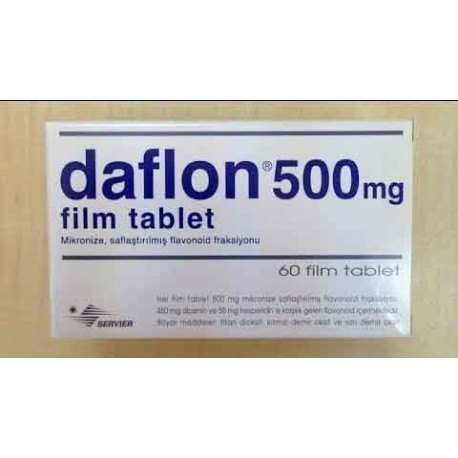 View larger
View larger Daflon Diosmin Complex ( hesperidin) 500 Mg 60 Tablets
DFLN4568
New product
BUY MORE PAY LESS
| Quantity | Discount | |
|---|---|---|
| 2 | 5% | |
| 3 | 10% | |
| 4 | 15% | |
| 5 | 20% |
Volume discounts
| Quantity | Discount | You Save |
|---|---|---|
| 2 | 5% | Up to $3.90 |
| 3 | 10% | Up to $11.70 |
| 4 | 15% | Up to $23.40 |
| 5 | 20% | Up to $39.00 |
More info
CLINICAL FEATURES
4.1. Therapeutic indications
• It is effective in the treatment of symptoms of chronic venous insufficiency of the lower extremities:
- a feeling of heaviness,
- pain,
- nighttime cramps.
• It is indicated for the treatment of functional symptoms of hemorrhoid crises.
4.2. Posology and method of administration
Posology / Application frequency and duration:
- In venous insufficiency: 2 tablets per day. The daily dose is taken twice with lunch and dinner.
receivable.
- In hemorrhoid crises: first 4 days, 6 tablets a day. Next 3 days, 4 tablets a day.
Method of Application:
It is used orally.
Additional information on special populations:
Kidney failure:
It does not require dose adjustment.
Liver failure:
It does not require dose adjustment.
Pediatric population:
DAFLON is not recommended for use in children and adolescents under the age of 18, as there is insufficient data on its safety and efficacy.
Geriatric population:
Does not require dose adjustment
4.3. Contraindications
It is contraindicated for those who are hypersensitive to the active substance or the excipients listed in section 6.1.
4.4. Special use warnings and precautions
Acute hemorrhoid episodes: Administration of this drug does not interfere with the treatment of other anal complaints. Treatment should be short-term. If the symptoms do not pass quickly, proctological examination is required and treatment should be reviewed.
4.5. Interactions with other medicinal products and other forms of interaction
No interaction studies have been conducted. However, no clinically relevant drug interactions have been reported since post-marketing experience began.
Additional information on special populations:
There is no data.
Pediatric population:
There is no data.
4.6. Pregnancy and lactation
General advice
Pregnancy category: B
Women with childbearing potential / Contraception
Due to the lack of data or limited data available, women of childbearing potential should use appropriate contraception throughout their DAFLON treatment. There are no data on interactions between DAFLON and contraceptives.
Gestation period
There are no or limited data available on the use of the micronized flavonoid fraction in pregnant women. Studies in animals do not indicate reproductive toxicity (see section 5.3).
As a preventive measure, it is recommended to avoid the use of DAFLON during pregnancy.
Lactation period
It is not known whether the active substance / metabolites are secreted into breast milk or not. Risk cannot be excluded in newborns / infants.
The decision whether to continue breastfeeding or treatment with DAFLON should be made considering the benefit of breastfeeding on the child and the treatment on the mother.
Reproductive ability / fertility
No effects on reproductive ability were seen in reproductive toxicity studies in male and female rats (see Section 5.3).
4.7. Effects on ability to drive and use machines
The specific effect of the flavonoid fraction on the ability to drive and use machines has not been studied. However, based on the overall safety profile of the flavonoid fraction, DAFLON has no or negligible effect on the ability to drive or use machines.
4.8. Unwanted effects
During the treatment, the following undesirable effects were seen and classified as follows according to the MedDRA system: Very common (> 1/10); common (> 1/100 to <1/10); uncommon (> 1 / 1,000 to <1/100); rare (> 1 / 10,000 to <1 / 1,000); very rare (<1 / 10,000), not known (cannot be estimated from the available data).
Nervous system disorders:
Rare: Dizziness, headaches, malaise, including dizziness.
Gastrointestinal diseases:
Common: Diarrhea, indigestion, nausea, vomiting.
Uncommon: Inflammation of the large intestine (colitis).
Not known: abdominal pain
Skin and subcutaneous tissue disorders:
Rare: Rash, pruritus, urticaria.
Unknown: Isolated edema of face, lips, eyelid. The exception is Quincke's edema.

